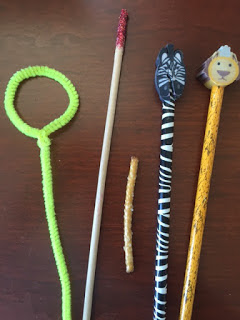It used to be so much more fun to be a teacher. It’s more difficult now because of academic pressure, data, test scores, and lack of support from parents. I worry about you because it seems so many of you are getting “beat up” by evaluations and unrealistic demands. Think of me as your “grandmother consultant” who hugs you and tells you that you’re doing a great job...BECAUSE YOU ARE!

A friend who taught with me over 40 years ago visited recently and said, “I remember how you would take the most pitiful little child and write on their hand: YOU ARE AMAZING AND WONDERFUL! Or, YOU ARE BEAUTIFUL! Or, YOU ARE SPECIAL! She said, “Why did you do that?” My response was, for once in their lives, I wanted them to feel that way. I wanted them to know that someone believed in them. (Now they’d probably throw me in jail for writing on a child’s hand, but you get the point.)

Sometimes you just have to shut your door and do what’s best for your children. Do what my momma said, “Love them and be sweet to them!”
TIS’ YOU
(Tune: “Simple Gifts”)
Jean Feldman and Hollynd Feldman Karapetkova
Tis’ you who cares,
And tis’ you who shares.
Tis’ you who teaches
Children everywhere.
Tis’ you who inspires,
Tis’ you who molds.
You help children’s gifts
And dreams unfold.
Tis’ you our teachers
Everywhere
For some child you’re the
Only one who cares.
And when you come at last
To the end of your days,
I have touched a life
Is what you can say.
It’s not the test scores.
It’s not the workbooks.
Into the hopeful eyes
Of each child you must look.
You plant the seeds of learning
With smiles and grace.
Each day you make the world
A better place.
Tis’ you our teachers
Everywhere
For some child you’re the
Only one who cares.
And when you come at last
To the end of your days,
I have touched a life
Is what you can say.
TEACHERS WHO LOVE TEACHING MAKE CHILDREN WHO LOVE LEARNING!
Administrators rarely come to my workshops. (Gee, I wonder why???) Here’s some advice I’d like to give them. What would you add to this list?
WHAT CAN ADMINISTRATORS DO TO HELP TEACHERS LOVE THEIR JOBS?
1. Let your teachers TEACH. Give them autonomy to do their jobs and TRUST them to do what’s best for their students.
2. Be a real person and a good model for your teachers. Visit each classroom and do something FUN by reading a book, teaching a song, telling a joke, or doing a magic trick.
3. Support your teachers. Be careful not to let a single parent’s request sway what’s best for their child and the other children in the classroom.
4. Believe in the WHOLE child. A test score is a number. “You can’t see the forest for the trees.” And, sometimes, you can’t see that wonderful little person because of “data.”
5. The word “rigor” is not appropriate when talking about instruction for young children. The world keeps changing, but children are still children. They don’t all grow up in the same way at the same time, and they should not be expected to accomplish skills according to some master plan.
6. Please don’t give teachers any more paperwork. Assessment and reports are driving instruction and consuming their day.
7. Teaching is a video not a snap shot. Is it fair to walk in a classroom, observe for 10 minutes, and then make negative comments to the teacher? Compliment teachers for what they are doing well. Give positive suggestions instead of critical remarks.
8. Listen, listen, listen to your teachers. Problem-solve, ask for their input, and collaborate on goals and issues. Instead of TELLING them, ask for their help and suggestions.
9. Don’t take away their JOY! If the children are engaged and enjoying an activity, do you have to ruin it by requiring “observable evidence”? Let it be! It’s O.K. to read a book without dissecting it with questions about the author’s purpose. It’s O.K. to take a walk outside to enjoy the peace and beauty of nature. It’s fine to sing a song or use a brain break to make children smile.
10. Remember that for some of your students “school” is as good as it’s going to get for them. You never know what’s going on at home, and school should be a wonderful world where they feel accepted, successful, and excited about learning!
O.K. I’M THROUGH PREACHING!!! Tomorrow will be ACTIVE AUGUST with creative strategies to help kids learn as they move.


















































